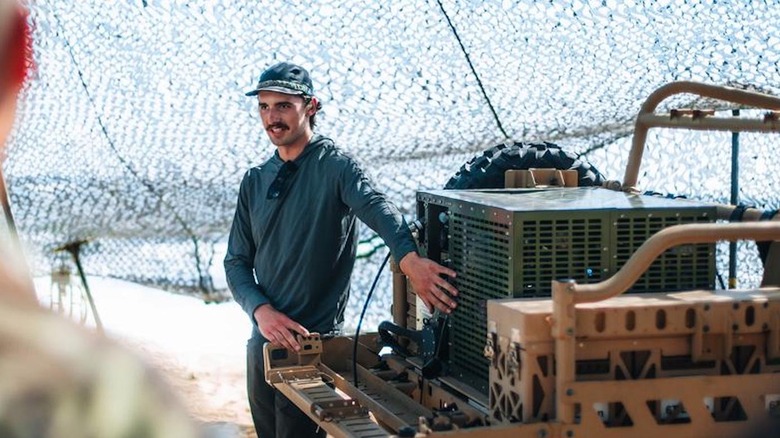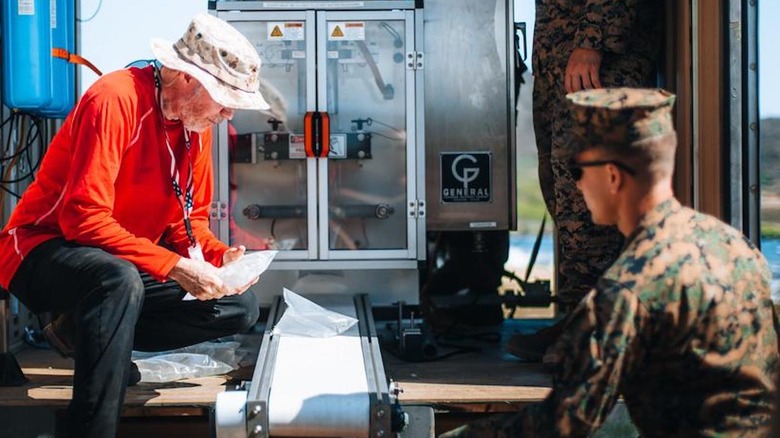The U.S. Marine Corps' New Water Invention Could Change Everything
Food insecurity is a growing issue that isn't easy to solve, but water is something else entirely (via CDC). With increasing accounts of contaminated waters in more U.S. cities and across the globe, it's refreshing to hear about new technologies that can solve these crises with relative affordability. The U.S. Marines have developed a water generation system that can grab the liquid life-giving substance from mid-air by the gallons, the Honolulu Star-Advertiser reports.
According to Capt. Sean Conderman, who leads the 3rd Marine Littoral Regiment's combat ballistics battalion in Hawaii, the machine essentially combines the powers of a dehumidifier with a water purifier. "We can mount it basically on any vehicle, and what it does is it pulls water out of the air to give us potable water without having to connect to an actual water source," said Conderman, whose squad works out of the Marine Corps Base in Kaneohe, Hawaii. The machine can generate up to 20 gallons of water per day, enough to fuel a small team of 10 to 20 through a short journey.
How does it work?
The Marine Corps is calling this device an Atmospheric Portable-water Sustainment Unit, APSU for short. Combined with what it calls the Lightweight Water Purification System, it essentially grabs the moisture from humid air and converts it to liquid. From there, it purifies the water to ensure it's drinkable, as even airborne water can contain trace amounts of atmospheric chemicals. It's more than just a proof of concept at this point, too.
The next steps are to make it as portable, rugged, and convenient as possible for mobile military use. For power, the Corps is exploring the use of lithium ion batteries which can power the unit for up to 72 hours. The service branch is also considering how to contain and transport the liquids generated. Currently, it's storing the water in huge jugs, but eventually would like to implement a portable bottling system to make it easier for platoons to fill up.
This initial iteration is designed for mobility. It can be fitted on almost any vehicle, but the Marines are also exploring bigger units that can generate up to 200 gallons per day, likely to facilitate a temporary or permanent base. It also has the ability to collect and purify rainwater. Humid locales are the ideal target for its use, says Conderman.
Keeping the military mobile despite supply chain issues
It's hard to believe that the world is still in the throes of a supply chain disaster caused by a series of global events that began in 2020, starting with the rise of the COVID-19 pandemic (as reported by the United States Department of Agriculture) and has been exacerbated by ongoing conflicts between significant European and Middle Eastern nations. Compounding those issues are growing fears of a recession and increasingly loud calls for truckers to strike against the rising costs of doing business. In turn, food is not just costlier to produce and transport, but also takes more time to move from one corner of the globe to another. The record droughts that continue to challenge communities across the world aren't helping either, with rivers in some places drying up completely.
On the civilian side, it's impacted low-income communities and those living in zones designated as "food deserts," mostly rural residents who stay far outside big city limits. But it could eventually hurt military operations, an important consideration for the U.S. government, which is engaged in numerous mobile deployments abroad.
As you may know, food and water are the most important resources for maintaining a functional military.oldiers can't fight if they can't eat. With the APSU, Marines will be able to patrol the Pacific and its many islands with a lot more flexibility, making for new deployment strategies and advantages that weren't previously available.
Will this tech eventually land for civilians?
Naturally, many are wondering whether such a brilliant concept will be deployed to service the aforementioned communities at risk. Outside of cost, there's no major reason we can think of that should keep it from proliferating in society, but it's a huge consideration all on its own. Though cost wasn't specified, it's unlike this is cheap to develop, deploy, and maintain. If past technological advancements are anything to go on, it could be years before we see cost-effective systems that can be adopted by municipalities on a wide scale. Even then, there is likely to be lots of red tape to figure out who will foot the bill. For civilians hoping to buy something on a smaller scale? We could be waiting at least a decade.
That sounds like bad news in a vacuum, but the reality is that this has the potential to be world-changing technology, and we can think of no other piece of kit on the planet more important than this. It'd be well worth the wait.



